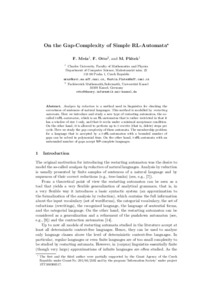On the Gap-Complexity of Simple RL-Automata
| dc.date.accessioned | 2006-05-31T11:53:52Z | |
| dc.date.available | 2006-05-31T11:53:52Z | |
| dc.date.issued | 2006 | |
| dc.identifier.uri | urn:nbn:de:hebis:34-2006053112600 | |
| dc.identifier.uri | http://hdl.handle.net/123456789/2006053112600 | |
| dc.format.extent | 212895 bytes | |
| dc.format.mimetype | application/pdf | |
| dc.language.iso | eng | |
| dc.rights | Urheberrechtlich geschützt | |
| dc.rights.uri | https://rightsstatements.org/page/InC/1.0/ | |
| dc.subject | analysis by reduction | eng |
| dc.subject | restarting automata | eng |
| dc.subject | gap-complexity | eng |
| dc.subject | complexity of membership problems | eng |
| dc.subject.ddc | 004 | |
| dc.title | On the Gap-Complexity of Simple RL-Automata | eng |
| dc.type | Preprint | |
| dcterms.abstract | Analysis by reduction is a method used in linguistics for checking the correctness of sentences of natural languages. This method is modelled by restarting automata. All types of restarting automata considered in the literature up to now accept at least the deterministic context-free languages. Here we introduce and study a new type of restarting automaton, the so-called t-RL-automaton, which is an RL-automaton that is rather restricted in that it has a window of size one only, and that it works under a minimal acceptance condition. On the other hand, it is allowed to perform up to t rewrite (that is, delete) steps per cycle. Here we study the gap-complexity of these automata. The membership problem for a language that is accepted by a t-RL-automaton with a bounded number of gaps can be solved in polynomial time. On the other hand, t-RL-automata with an unbounded number of gaps accept NP-complete languages. | eng |
| dcterms.accessRights | open access | |
| dcterms.creator | Mráz, František | |
| dcterms.creator | Otto, Friedrich | |
| dcterms.creator | Plátek, Martin | |
| dcterms.isPartOf | Mathematische Schriften Kassel ;; 06, 02 | ger |
| dcterms.source.journal | Mathematische Schriften Kassel | ger |
| dcterms.source.volume | 06, 02 |

